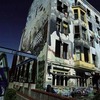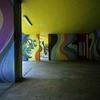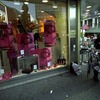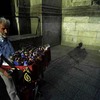Gypsies groups clamour for Holocaust memorial
BRADLEY (EJP)--- For well over a decade, the Central Council of German Sinti and Roma (CCGSR), which represents the two primary Gypsy groups living in Europe today, have been petitioning the German government to build a memorial in Berlin that would honour their dead.
The first major breakthrough took place at the inauguration of the Memorial to the Murdered Jews of Europe in Berlin, two years ago.
During his speech at the memorial?s opening, former Central Council of Jews president Paul Spiegel, appealed to the German government to also not forget its obligations to other minority groups that had been subjected to Nazi atrocities - now that it had fulfilled part of its commitments to the Jewish communities. He referred specifically to Gypsies and homosexuals.
?Now the German government must finally begin addressing the question of when it will finally build a monument also to the murdered Sinti and Roma of Europe,? Spiegel said in his speech.
Since taking the helm of Central Council of Jews in Germany in 2000, Spiegel had made it part of his programme to also speak out for all minority groups whose voices, he felt, were not being heard adequately by the German government. He began by supporting Romani Rose, long-time president of the CCGSR, to lobby the German government for a Sinti and Roma monument.
Longterm project
Although funding and the location of a Sinti and Roma memorial was already agreed upon in February 2005, only in May of this year did it look as if the federal government and the CCGSR had finally found a consensus concerning the final plans for the monument.
The memorial is supposed to be erected just south of the Reichstag building ? home of Germany?s lower house of parliament. The government also guaranteed 2 million euros towards its construction.
The federal state secretary for culture, Bernd Neumann, said in a press conference that most of the hurdles up until May had mostly to do with the wording of plaques that are to be mounted around the memorial site.
He underlined that his May meeting with Rose was only intended to lead to a tentative agreement and that the other political parties still needed to be consulted about the final plans.
Rose claims not to have been aware of this. As far as he was concerned, construction of the monument could have begun ever since the government had agreed not to make any mention of the word ?gypsy? on any of the plaques. According to the CCGSR, the term gypsy is a foreign word that had been filled with too many negative clich?s. Also, until May, the government held most of its discussions with the CCGSR ? the largest lobby group for the Sinti and Roma living in Germany.
Continuing struggle
Since the May meeting, the smaller Sinti Alliance, a competing organisation, raised its voice against the proposed omission of the names of all smaller Roma groups from the plaques. It feels that all Roma groups subjected to Nazi persecution needed to be immortalised at the monument to make it a relevant site. The Sinti Alliance has since found support for its call to further modify wording of the plaques from the cultural committees of the Free Democratic and Social Democratic parties.
On July 17, Neumann asked Romani Rose to return to the negotiating table in order to take the Sinti-Alliance?s recommendations into account. Because Rose feels that the CCGSR is the only true voice of the entire Sinti and Roma, he has so far refused to continue any talk and has, instead, begun a media campaign blaming the government for any delays.
Analysts believe that the more than 15 years of squabbling between Jewish groups, civic organisations and parliament, that preceded the construction of the Monument to the Murdered Jews of Europe, could be a barometer of the wait that the Sinti and Roma may have in store for them.
Israeli architect Dani Karavan won the tender for the construction of the monument. It will be an obelisk mounted on top of a contemporary fountain. Some of his sculptures have already been erected in Germany, including one located within the courtyard of one of Berlin?s parliamentary office buildings.





